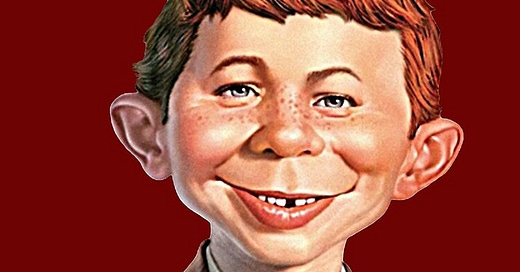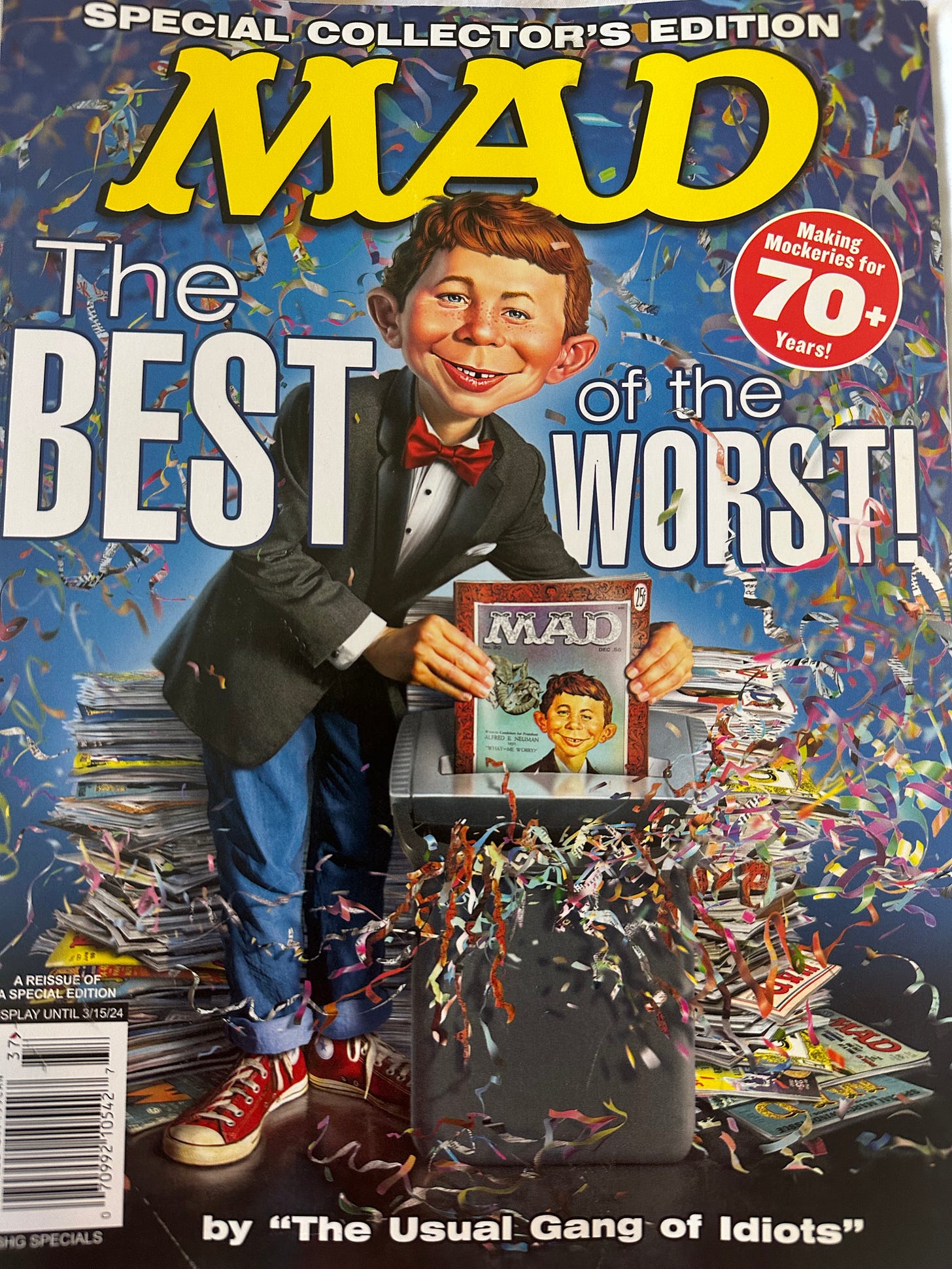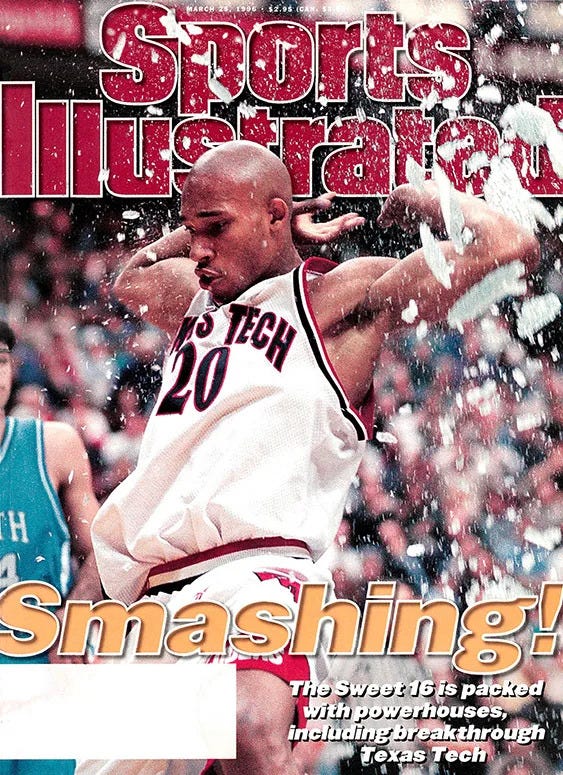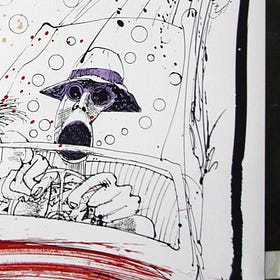My nine-year-old son joined me on a run to our neighborhood CVS recently to pick up a prescription. While in the pharmacy line, a special edition MAD caught his eye.
He didn’t know MAD nor the type of content it produced, but something about that iconic artwork — in this compilation of greatest hits, depicting Alfred E. Newman shredding copies of the magazine — spoke to his tastes.
He pulled one from the rack and started to flip through. He chuckled at a cartoon before holding it open to me and asked what the punchline meant.
It felt like I’d just exited the DeLorean and encountered myself at the same age some time in the 1990s, when I joined my parents on grocery store trips and would park myself in the magazine aisle. I thumbed through each month’s edition of GamePro for video-game rental inspiration, and I’d laugh at MAD — even when the jokes went over my head.
And, indeed, MAD’s gags often went over my head. But there was enough silliness and juvenile humor intertwined with its biting social commentary and political satire that, coupled with its distinctive artwork, even the material I didn’t understand still tickled me.
MAD was a lot like The Simpsons in that way. I fell in love with both around the same age for similar reasons, and came to appreciate how smart each was later in life. MAD and The Simpsons shaped my sense of humor more than any other influences.
Similarly, my view of what constituted peak sports journalism was shaped reading magazines in the 1990s; specifically, Sports Illustrated.
SI having profound influence on me as an aspiring and working sports journalist hardly makes me unique. There was a time when I assumed it did, going through journalism school with no shortage of peers who aspired to emulate Bill Simmons’ style of fan-centric, opinion-drive commentary.
But, when you’re young, you make a lot of assumptions thinking you know more than you do. And to cite one of my all-time favorite throwaway line in Saturday Night Live history:
For one thing, I’ve come to recognize that Simmons’ first-person narrative style was probably far more influenced by Rick Reilly’s Sports Illustrated back-page columns than some would want to admit. Simmons, and by extension the first wave of the sports blogosphere, have the fingerprints of 1990s SI in that regard.
More directly, reading the flood of eulogies for SI written in the past week, with vulture capital outfit The Arena Group ostensibly killing the publication, underscored how very not-unique SI’s influence on me was.
Our individual entry points are unique. For me, my parents purchasing copies of SI For Kids (as well as the children’s pop-culture pub Disney Adventures) for me planted the seed for my love of magazine-style content.
I can’t recall a specific Sports Illustrated edition that marked my transition from Kids to the standard edition. The first specific cover I remember from an SI I read front-to-back captured Texas Tech’s Darvin Ham showered in broken glass following a dunk in the 1996 NCAA Tournament.
Like my son seeing that MAD cover, something in the artwork captured my imagination. That it still resonates almost 30 years later is a testament to just how profoundly it spoke to me, and anyone who ever consumed Sports Illustrated can share similar stories on other covers.
But this isn’t another eulogy for SI — as noted, plenty have been produced in the past week that both celebrate its decades of life and lament its demise. I take some issue with how the latter has been covered in general, pinning blame almost exclusively on The Arena Group.
Certainly the organization bears the lion’s share of responsibility, catering what was a salvageable brand. But that The Arena Group was even in position to take over the most recognized name in sports media outside of ESPN was a byproduct of a previously mismanaged business model reflective of the industry as a whole.
The Internet. The Internet, the Internet, the Internet. I’m not broaching new ground here — realistically, I’m just reiterating cries that predate me enrolling in journalism school. And that was a long time ago!
Asking customers to pay for a hard-copy product while giving away much of the same product online created a quagmire that damaged damn-near every magazine and newspaper around the country.
An assortment of quick-fix attempts have proven to be Vaudeville-era snake oil peddled by charlatans. Pivot to video! Bombard the Google algorithm! SI attempted both, the latter well before The Arena Group’s takeover when it aggregated low-quality Fansided content in order to game search engines.
I can’t say definitively what may have worked in the years since print’s decline, but it’s not exactly armchair-quarterbacking to point out tactics that have been attempted have failed.
Something that really hasn’t been tried from my perspective is patience. Decisions made chasing analytical data collected over short periods of a time —- a month? A week? A day? Hell, each hour? — cause panic.
For as much of an industry giant as it became, setting the standard for sports journalism across generations, Sports Illustrated went more than a decade in its silver age before turning a profit.
Outlets today are fortunate to get 12 months, let alone 12 years before the plug’s pulled.
Meanwhile, have too many self-appointed data scientists who aren’t opining about “moving the needle,” a phrase I have come to detest, based on microscopic sample sizes.
The direct result of this strategy has moved the metaphoric needle, alright, but it’s a syringe of heroin. Junk gets pumped out into the cultural blood system that isn’t good for anyone beyond the very short-term high being antagonistic spikes on Google Analytics.
It’s called hate-engagement, and it’s increasingly the fall-back across a wide spectrum of the media landscape — certainly not just sports. Chasing the high some good, old-fashioned trolling temporarily generates leads to more of it, and it’s collectively making us as a society meaner and more ignorant.
That’s not to suggest hate-engagement didn’t exist before digital publishing. To wit, Jay Mariotti wrote for The National, the short-lived sports-focused newspaper of the early ‘90s, then The Chicago Sun-Times for years after.
But Mariotti’s columns occupied a fraction of the overall Sun-Times product. That’s one key component digital publishing has never been able to replicate, and arguably not given sufficient time to let foster, are multifaceted outlets readers peruse for a variety of topics.
ESPN’s Page 2 in its infancy came close to capturing this, back in the days when Hunter S. Thompson and Ralph Riley wrote there and before it was commandeered to centered around a single personality.
Hunter Thompson, Sports Journalist
My first exposure to Hunter S. Thompson, or at least the idea of Hunter S. Thompson, was through the 1998 film adaptation of Fear and Loathing in Las Vegas, which I suspect is the case for a majority of millennials.
That’s another magic bullet solution to publishing and media woes that doesn’t seem to be working, either: Personality-driven content. It fits in the same category as hate-engagement to some extent, albeit with some differences.
Those in position to give others platforms love so-called lightning rods. “Polarizing” is considered a virtue — and that’s been true for generations. The inherent problem is that, while polarizing figures attract loyal followers, they also drive away others.
If your product is built around a figure actively driving a portion of the audience away, it’s a bad strategy. ESPN seems to be running into that currently with Pat McAfee, who certainly has his loyal followers but actively turns others off of Gameday.
SI had its brand-name writers, to be sure, but the magazine was never built around any one journalist. The overall product was so strong that any given edition guaranteed something for all sports fans.
The overall disappearance of physical media has been a net-negative for culture in the last 15 years. We have dozens of streaming services available to us in seconds, but nothing that matches the experience of discovering a new at the video store.
Hell, I can’t even find one film I’ve been actively searching out to re-watch for the first time since college, the brilliant Shadow of the Vampire on any of the bevy of platforms that currently exist.
The financial sinkhole that many of these streaming services have become offers me some hope that just maybe, we’ll come full-circle and demand the return of physical media.
It’s anecdotal, sure, by my Gen Alpha son prefers holding a paper copy of One Piece in his hands to accessing the manga series through Kindle — and he’s a kid who will typically do anything to get to use the iPad!
Likewise, seeing his face light up and him smiling back at the grinning visage of one Alfred E. Newman suggested that just maybe, what was obsolete for one generation becomes novel to another.
And as for me, writing the preceding on a digital platform and experiencing the same angst hundreds of others expressed in the past week with the decimation of an inspiration, I’ll try my best to take some words from the MAD mascot to heart:







